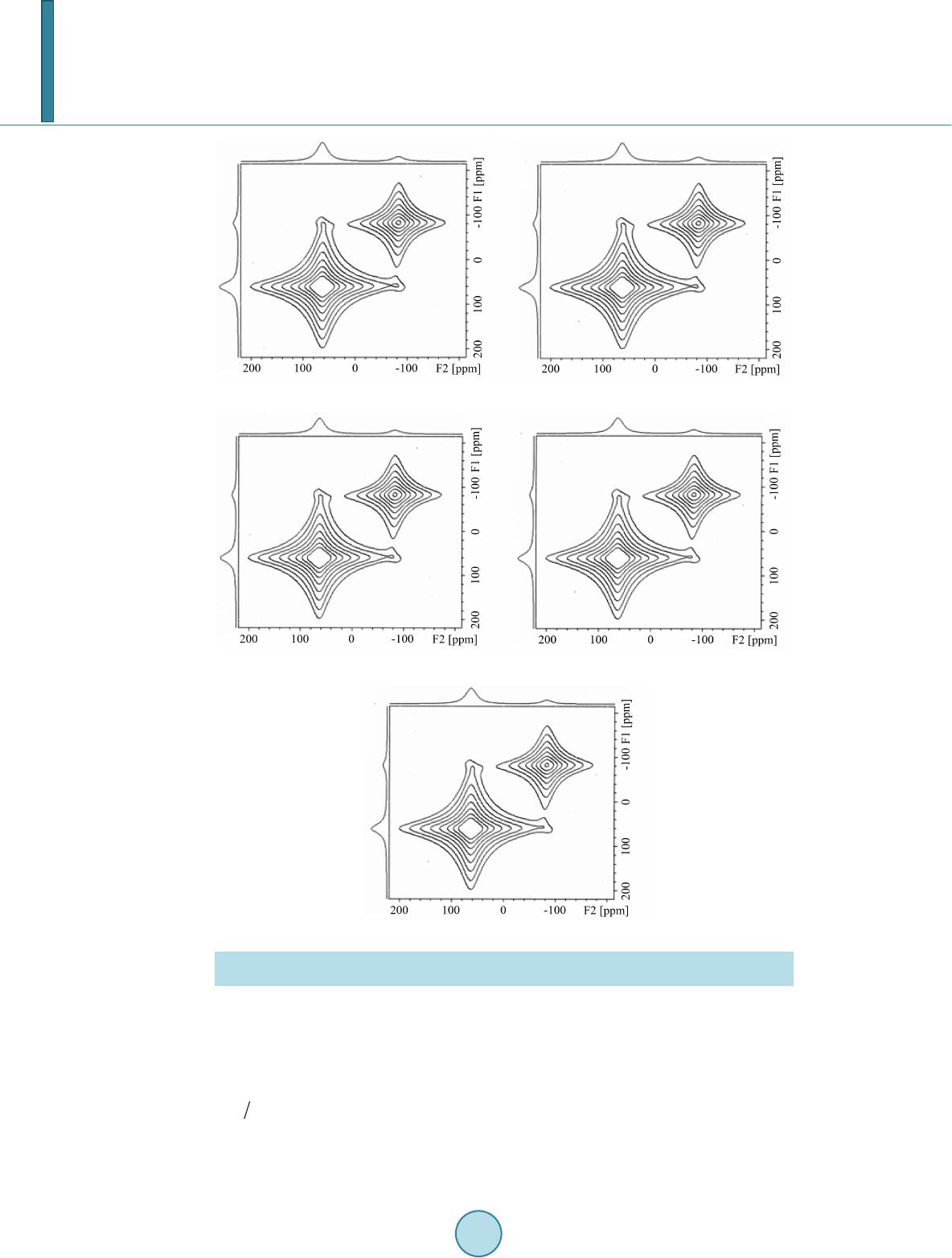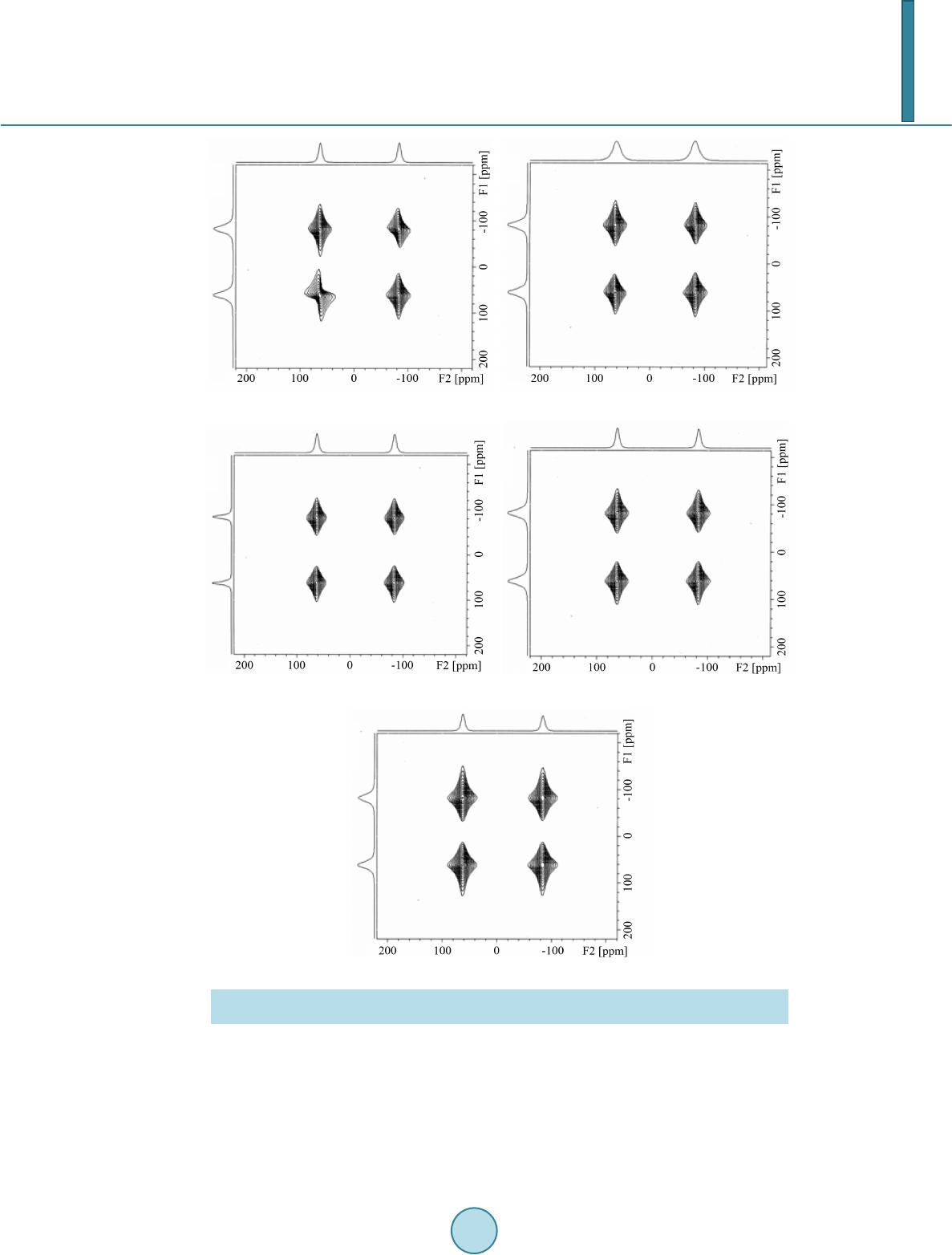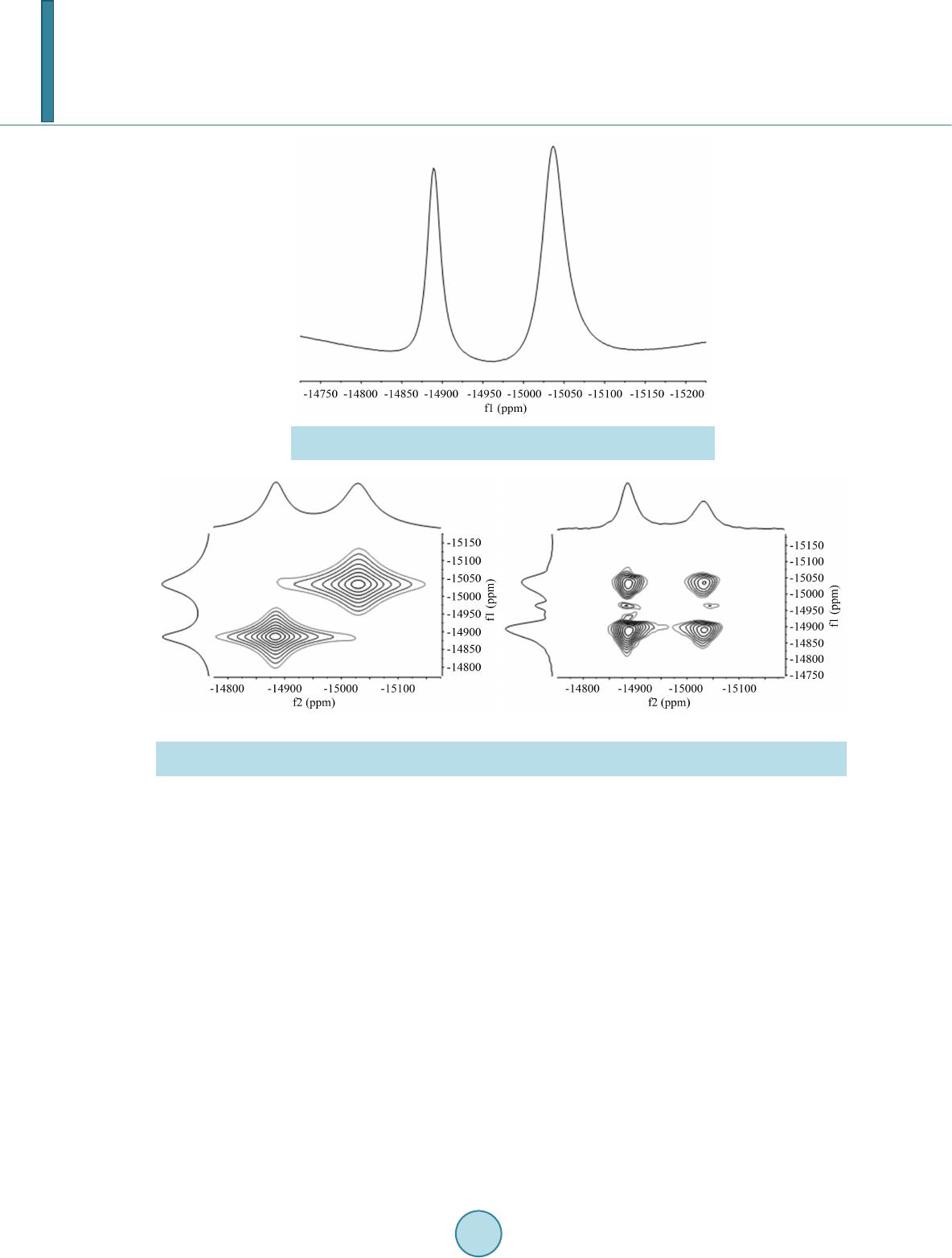 Open Access Library Journal, 2014, 1, 1-9 Published Online June 2014 in OALib. http://www.oalib.com/journal http://dx.doi.org/10.4236/oalib.1100622 How to cite this paper: Rosé, J. and Kempgens, P. (2014) The DQF-COSY NMR Experiment, a Way to Detect Small J Coupl- ings in the Case of Fast Relaxing Nuclei: Application to 59Co in the Tetrahedral Mixed-Metal Cluster HRuCo3(CO)11(PPh3). Open Access Library Journal, 1: e622. http://dx.doi.org/10.4236/oalib.1100622 The DQF-COSY NMR Experiment, a Way to Detect Small J Couplings in the Case of Fast Relaxing Nuclei: Application to 59Co in the Tetrahedral Mixed-Metal Cluster HRuCo3(CO)11(PPh3) Jacky Rosé1, Pierre Kempgens2* 1Laboratoire de Chimie de Coordination, Institut de Chimie (UMR 7177 CNRS), Université de Strasbourg, Strasbourg, France 2Department of Chemistry, Rhodes University, Grahamstown, South Africa Email: *P.Kempgens@ru.ac.za Received 30 April 2014; revised 1 June 2014; accepted 11 June 2014 Copyright © 2014 by authors and OALib. This work is licensed under the Creative Commons Attribution International License (CC BY). http://creativecommons.org/licenses/by/4.0/ Abstract The first investigation and analysis of 59Co 2D NMR homonuclear chemical shift correlation spec- tra for a ru thenium-based tetrahedral mixed-metal cluster HRuCo3(CO)11(PPh3) are reported. For this cluster in solution and by contrast to the conventional COSY NMR experiment, the double- quantum filtered (DQF) COSY NMR spectrum proves the existence of a scalar coupling constant between 59 Co nuclei. In order to obtain a value of this coupling, the 2D COSY spectrum for a three- spin 7/2 AX2 system has been simulated by numerical density matrix calculations. The comparison between experimental and theoretical 2D NMR COSY spectra gives a spin-coupling constant Hz for this cluster. Keywords NMR, Cobalt-59, 2D COSY and DQF-COSY, Scalar Couplings, Tetrahedral Mixed-Metal Cluster Subject Areas: Computational Chemistry, Inorganic Chemistry *Corresponding author.  J. Rosé, P. Kempgens 1. Introduction The conventional COSY NMR experiment [1] is an efficient and powerful technique to prove qualitatively the existence of a coupling constant between quadrupolar nuclei. Ho wever, most of the investigations performed so far co ncern nucle i with s mall quad rupole mo ments suc h as 11B [2]-[10], 51V [11], 2H [12], 6Li [13]-[16] and 7Li [14]-[16], whose lines are relatively narrow (10 - 150 Hz) in the conventional 1D spectrum. The DQF-COSY NMR experiment has only been scarcely used in the field of quadrupolar nuclei, and o nly when the lines were broad in the 1D spectrum [17]-[19]. Recently, we have shown theoretically the superiority of the DQF-COSY NMR experiment when trying to detect and determine relatively small J couplings in the case of fast relaxing nucle i and broad peaks in the quadrupolar nucleus 1D NMR spectrum [20]-[24]. Idea l candidates for such NMR spectroscopic investigations are available in the realm of metal cluster chemistry [25]-[27], as p revi ousl y sho wn for HFeCo3(CO)L w ith L = PPh2H [17], PPh3, P(OMe)3, PCy3 [18] and HFeCo3(CO)10(PC yH 2)(P P h2)[CH2C(O)Ph] [19]. Tetrahedral mixed-metal clus ter s co ntaini ng r uthe niu m ha ve b een sho wn to have d iffere nt c hemi cal sh ift s and line wid ths in the 59Co 1D NMR spectrum than their iron-based counterparts [28]. The effect of a change in the apical metal (Fe or Ru) on the 59Co chemical shifts has been studied in detail on a large number of these clusters [28]. A study of the line widths has clearly shown that the apical atom plays an important role in the electron distribution at the cob alt atom [28]. This is t he case for HR uCo3(CO)11(PPh3) (F igu re 1 ) in CDCl3 which is the subject of this paper. Since we have demonstrated experimentally the feasibility of using the DQF-COSY ex- periment to dete ct and d etermine rela tively small J Co-Co couplings in an iron-based tetrahedral mixed-metal cl us- ter giving rise to broad lines in the 59Co 1D NMR spectrum (2.5 - 4.5 kHz) [19], it was of interest to test the metho d o n a r utheniu m-based tetrahedral mixed-metal cluste r suc h a s H R uCo 3(CO)11(PPh3), because the lines in the 59Co 1D NMR spectrum are even broader than those for the iron-based analog [28] [29]. Indeed, the line- widths for the iron-based cluster in CD2Cl2 are 1500 Hz and 1600 Hz while the linewidths for the ruthe- nium-ba sed cl uster in CD Cl3 are 5100 Hz and 2900 Hz, keeping in mind that CD2Cl2 and CDC l3 have compara- ble viscosities. Furthermore, it was felt interesti ng to determi ne the JCo-Co scalar coupling constant and compare its value with those found previously for iron-based tetrahedral mixed-metal clusters. The JCo-Co coupling re- ported here is the first one for a rut henium-based tetrahedral mixed-metal cluster. 2. Theory For the co nventi ona l C OSY experi ment, the comple x sig nal may be written as [20] ( ) () () ( ) () ( ) ( ) 121,,,, 1,212 2, 2, ,, ,exp expexpexp NN rstu utsrtu rs r stu tu sttCZitittTt T + > =Ω Ω×−− ∑∑ (1) where is a constant of proportio nality. This last equatio n is valid for an AX system of any spin S. It is also valid for a n A MX s yste m o f s p ins S = 7/2. Rela xation was introd uced through rela xation o f transitio ns (t, u) a nd (r, s) d uring evolution and detection perio ds, respectivel y. In this last equation, N is the number of the quantum states of the spin s ys t em. The comple x inte nsity is defined by [20] ( )() ( ) ( ) ( )() ( ) ( ) 11 ,,, ,,1,,1 90,90 ,90 ,90, 00 xx rstu srtusrtu xrt xusyrtyus ZSRRtSRRt σσ +− +− == == (2) Figure 1 . Schematic of the H R uCo3(CO)11(P Ph 3) cluster.  J. Rosé, P. Kempgens The density matrix element represents the initial amplitude and phase of a coherence compo- nent associated with a transition at the beginning of the evolutio n period. The selection rules of obser- vation are represented by the raising operator ( )( ) ,,, sr xsr ysr S SiS + = + , where Sx and Sy are the x and y components of the total angular momentum spin operator. The coherence transfer amplitude which describes the transfer of coherence from transition between two states |t> and |u> to a transition bet we e n t wo s ta t es |r> a nd |s> is equal to the product of two rotation matrix elements. The peak intensities are determined by the amplitude of coherence transfer, taking into account the limitations imposed by coherence transfer selection rules. For the DQF-COSY NMR experiment, the complex signal may be written as a function of the same complex coefficients needed to calculate the 2D COSY NMR spectrum of the same spin system [21] [22] ( ) () ()() ( ) ( ) ( ) ( ) ( ) 122,,,, 1,,,1,11 ,, ,2 12 2, 2, ,expexp 2exp exp expexp NN rstuutrstuNrN s rs tu tu sr tu rs s ttCZitiit i ttTtT + +− +− > =−Ω− Φ−−Ω× Ω− − ∑∑ (3) with the s ymbols having the same meani ng as before and C2 being a constant of proportionality. For an AMX system of spin-7/2, there are (512) complex intensities and these factors were calculated numerically with a program written in Fortran 77. The knowledge of the complex intensities allowed us to ex- pand Equations (1) and (3) and two other programs written in C use the expressions we have obtained to com- pute the free induction decays for incremented values of t1 for the conventional COSY and the DQF-COSY NMR experiments, respectively. 3. Theoretical Simulations F igure 2 and Figure 3 illustrate the effect of t he J co upl i ng c o nstant o n the i nte n si tie s o f t he p ea k s, us i ng, i n the calculatio ns of a set of values corresponding to those found experimentally on our tetrahedral cluster. F igures 2(a)-(e) (COSY) and Figures 3(a)-(e) (DQF-COSY) were generated for , , and 20, 40, 60, 80 and 100 Hz J= , respectively. Data were apodized in bot h dime nsions a nd t he data matr ix obtained after 2D Fourier transformation of in both domains is drawn in the power mode as a contour plot. As expected, these 2D spectra are symmetrical about the diagonal, i.e. and inde pend ent of the sign of the coup ling constant J. These simulation s show that if small scalar coupling is present between the two nuclei A and X and if the re- laxation times T2A and T2X are short, it is not p ossible to detect the coupling with the co nventional COSY NMR experiment because the information we are looking for is obscured in the theoretical spectrum by the overlap of the inte ns e diagonal pe aks with the very small cr oss peaks. On the other hand, and as previously mentioned [24], it is possible i n the same si tuation to de tect the J coupli ng bet ween nuclei A and X with a 2D DQF-COSY NMR experiment, as observed in F ig ures 3(a)-(f). 4. Experimental The cluster HRuCo3(CO)11(PPh3) (Figure 1), synthesized according to the published procedure [30], was dis- solved in CD Cl3. 59Co NMR spectra were measured on a Bruker Avance II 600 spectrometer operating at 142.01 MHz. All spectra were run at room temperature. Chemical shifts are reported downfield from the exter nal refer- ence Co(acac)3 saturated in CDCl3. Experiments were performed with a pulse lengt h of 20 μs. All experi- ments were performed with an 1H(BB) 5 mm “inverse” probe-head using t he st andar d Bruke r so ftware. Typical parameters were as follows: , acquisition time , data points 256 (F2), 128 (F1) (COSY)/32 (F1) (DQF-COSY), recycle delay 40 ms (COSY)/10ms (DQF-COSY), number of scans 2048 (COSY)/16384 (DQF-COSY), exponential window function with a line broadening of 2000 Hz and power spec- tra in both dimensions. T1 relaxation times measurements have been performed on the cluster but due to the very long pulse length and also to the fact that the T1 relaxation times are around 100 μs, it was not po ssible to determine these relaxation times accurately. 5. Results and Discussion The 59Co NMR spectrum of the cluster HRuCo3(CO)11(PPh3) consists of two res ona nces ha vi ng i nt en s ities in the  J. Rosé, P. Kempgens (a) (b) (c) (d ) (e) Figure 2. 2D NMR COSY calculated power spectra with ωA = 11475 Hz, ωX = −8820 Hz, T2A = T2X = 100 μs and (a) J = 20 Hz (b) J = 40 Hz (c) J = 60 Hz (d) J = 80 Hz and (e) J = 100 Hz. ratio 1:2 (F i g u re 4 ). T here is no evidence in the 1D 59Co NMR spectrum for the existence of a J scalar coupling const ants between the non-equivalent 59Co nuclei, as previously observed for iron-based tetrahedral mixed-metal clusters [17] [18]. The cobalt nucleus bound to PPh3 (Co1) resonates at −14,888 ppm while the two equivalent cobalt nuclei (Co2) are observed at −15,028 ppm. The T2 value s of Co1 and Co2 esti mated from the line widths are equal to 110 and 60 μs, respectively, while it was not p ossible to measure the T1 relaxation times because of the very lo n g pulse and at the same time the very short T1 relaxation times (around 100 µs). As p re viou sl y explained for similar clusters [17] [18] , there should be a difference between T1 and T2 for the two cobalt nuclei due to the scalar relaxation of the second kind where T1 is different from T2 [31]. This mechanism implies the  J. Rosé, P. Kempgens (a) (b) (c) (d ) (e) Figure 3. 2D NMR DQF-COSY calculated power spectra with ωA = 11475 Hz, ωX = −8820 Hz, T2A = T2X = 100 μs and (a) J = 20 Hz (b) J = 40 Hz (c) J = 60 Hz (d) J = 80 Hz and (e) J = 100 Hz. existence of coupling constants and the fact that T1 and T2 are comparable indicates that the J coupling in our case, if it exists, is s mall but hopefully still d ete c ta ble by u sing DQF-CO S Y NMR exp eriments, as highlight ed in the theoretical simulations part of this paper. It was therefore of interest to obtain 59Co 2D COSY-type NMR spectra of our cluster. The 2D 59Co COSY and DQF-CO SY NMR spectra are shown in Figure 5(a) and F igure 5(b), respectively. In the 2D CO SY NMR spec trum (Figure 5(a)), cross peaks between the two resonances are not visible by contrast  J. Rosé, P. Kempgens Figure 4. 59Co NMR spectrum of the cluster HRuCo3(CO)11(PPh3) in CDCl3 at roo m temperature. (a) (b) Figure 5. 59Co 2D NMR power spectra of the cluster HRuCo3(CO) 11(PPh3) in CDCl3 at room temperature. ( a) Ex- perimental C O SY NMR spectrum. (b) Exp er imental DQF-COS Y NMR spectrum. to what happen in the DQF-COSY NMR spectrum (Figure 5(b)). This illustrates very well the fact that it is much easier in the case of quadrupolar nuclei relaxing very quickly to detect a relatively small J coupling in a 2D DQF-COSY NMR spectrum. In order to obtain a value for the 1J(59Co-59Co) coupling constant, the 2D 59Co COSY spectrum was analyzed according to the equations given above. In this analysis, it has been assumed that 1) the 59Co r elaxatio n is descr i bed with the ass umptio ns o f extreme narr o wing and s ingle c or relatio n time, 2) the decay of coherences for nuclei, A and X is described by a single transverse relation time and , resp ec- tively, and 3) the couplings between the 31P and 59Co nuclei (some values of 1JCo-P couplings in tetrahedral mixe d-metal clusters of general formula HFeCo3(CO)11L have been reported previously in the literature: 1JCo-P = 450 Hz with L = PPh2H [32] [33], 1JCo-P = 446 Hz with L = PCy2H [33], 1JCo-P = 573 Hz with L = PPh3 [33] and 1JCo-P = 750 Hz with L = [P(OMe)3] [1 8] [34]) and between 99Ru and 59Co nuclei (there has been no value of a 1JCo-Ru coupling reported in the literature before, to the best of our knowledge) are neglected. Note that according to our experience, taking into account the coupling between 31P a nd 59Co nuclei, as was previously done, does not change the fina l result for the 1J(59Co -59 Co) coupling constants [17] [18]. Attempts to analyze this 2D DQF-COSY NMR spectrum (not shown) did not give satisfactory results. This may be due to an irradiation problem because of the very long π/2 pulse length of 20 µs. In this case, it will de- finitively be useful to use solid-state NMR transmitters and probes and work with very short pulses as previ- ously done [17] [18]. Attempts to analyze the 2D COSY NMR spectrum (not shown) show that the cross peaks start to be visible for 1J(59Co-59Co) = 300 Hz. Therefore, as cross peaks are not visible on the experimental spectrum, this value is  J. Rosé, P. Kempgens Table 1. Parameters obtained from the analysis of the 1D 59Co spectrum of cobalt nuclei Co1 and Co2 in the cluster HRuCo3(CO)11(PPh3) and the 1J(59Co-59Co) scalar coupling constant determined from the simulation of the 59Co COSY NMR spectrum. Ligand (ppm) ∆ ν 1/2 (Hz) T2 (µs)a 1J(59Coi-59Coj) (Hz)b Co1 PPh3 −14,888 ± 10 2870 ± 200 111 (1-2) < 300 Co2 Unsub stitut ed −15,028 ± 10 5110 ± 200 62 aCalculated from the lin e width of each signal. bDetermined from the simulation of the 59 C o COSY NMR spectrum. an upper li mit for the 1J(59Co-59Co) coupling (Table 1). N ote that we suppo sed in the sim ulations that T1 = T2, T2 being obtained from the line widths, and this hypothesis is supported by the fact that the JCo-Co coupling is small in our case. It is of interest to compare the value of the 1J(59Co -59Co) coupling constant obtained in this work with those previously determined. The only ones known were determined in iron-based tetrahedral mixed-metal clusters and are surprisingly of the same order of magnitude compared to the 1J(59Co-59Co) coupling determined in this work: 1J(59Co-59Co) = (115 ± 20) Hz for HFeCo3(CO)11(PPh2H) [17], 1J(59Co-59Co) = 140 Hz for HFeCo3(CO)11(PPh3) [18], 1J(59Co-59Co) = (165 ± 15) Hz for HFeCo3( CO)11[P(OMe)3] [18], 1J(59Co-59Co) = 45 Hz for HFeCo3(CO)11(PCy3) [18] and 1J( 59Co-59Co) = (600 ± 150) Hz, 1J(59Co-59Co) = (450 ± 100) Hz, 1J(59Co-59Co) = (350 ± 100) Hz for HFeCo3(CO)10(P CyH2)(PPh2[CH2C(O)Ph]) [19]. This could be explained by the similarities between the phosphorous ligands used. Note that large differences were also observed for 1J(59Co-31P) s calar coupling const ants in ir on-based tetrahedral mixed-metal clusters [18] [32]-[35]. 6. Conclusion It has been shown in this paper that it is possible to detect cross peaks in a 2D DQF-COSY NMR spectrum when the relaxatio n times T1 are ver y sho rt a nd the l ine s in t he c onve nti ona l 1D NMR spec tru m are c onseq uent ly very broad. This is not the case for the conventional COSY NMR experiment. This case study demonstrates the feasi- bility of 2D DQF-COSY NMR experiments even in the case of very broad (2.9 - 5.1 kHz) lines in the conven- tional 1D NMR spectrum. The present data complement the previously reported 59Co-59Co J coupling constant s and therefore refer to a quadrupolar nucleus. It is believed that other metal-to-metal scalar coupling constants involving quadrupolar nuclei may be obtained by simulation of COSY-type 2D NMR spectra. Particularly, this work opens up the possibility of investigating other ruthenium-based tetrahedral mixed-metal cluster s with very broad peaks in the conventional 1D 59Co NMR spectrum. It is also believed that the methodology described in this paper will be applicable to study metal clusters of biological relevance. Acknowledgements JR would like to thank the CNRS (Centre National de la Recherche Scientifique) for suppo rt. PK would like to thank the Research Committee (RC) of Rhodes University for financial aid. References [1] Jeener, J. (1971) Ampere International Summer School, Basko Polje, Yugoslavia. [2] Reed, D. (1984) Applications of Two-Dimensional Nuclear Magnetic Resonance for the Boron Chemist. A COSY Study of Some Polyhedral Boranes. Journal of Ch emical Research, 198-199. [3] Venable, T.L., Hutton, W.C. and Grimes, R.N. (1984) Two-Dimensional Boron-11-Boron-11 Nuclear Magn etic Reso- nance Spectroscopy as a Probe of Polyhedral Structure: Application to Boron Hydrides, Carboranes, Metallaboranes and Metallacarboranes. Journal of the American Chemical Society, 106, 29-37. http://dx.doi.org/10.1021/ja00313a007 [4] Venable, T.L., Hutton, W.C. and Grimes, R.N. (1982) Atom Connectivities in Polyhedral Boranes Elucidated via Two -Dimensional J-Correlated Boron-11-Boron-11 FT NMR: A General Method. Journal of the American Chemical Society, 104, 4716-4717. http://dx.doi.org/10.1021/ja00381a053 [5] Hermanek, S., Fusek, J., Stibr, B., Plesek, J. and Jelinek, T. (1986) Elucidation of Structures of Ni do -y-CB8H12 and by T wo -Diemnsional 11B-11B NMR Spectroscopy. Polyhedron, 5, 1 873-1879. http://dx.doi.org/10.1016/S0277-5387(00)84871-8  J. Rosé, P. Kempgens [6] Jacobsen, G.B., Meina, D.G., Morris, J.H., Thomson, C., Andrews, S.J., Reed, D., Welch, A.J. and Gaines, D.F. (1985) Studies of 2,5;6,10;8,10-Tr i-µ-hydro-nonahydro-nonaborate(1−), [B9H12]−: Preparation, Crystal and Molecular Struc- ture, Nuclear Magnetic Resonance Spectra, Electrochemistry and Reactions. Journal of the Chemical Society, Dalton Transactions, 8, 1645-1654. http://dx.doi.org/10.1039/dt9850001645 [7] Fontaine, X.L.R., Fowkes, H., Greenwood, N.N., Kennedy, J.D. and Thornton-Pett, M. (1986) Pentamethylcyclopenta- dienylrhodaborane Chemistry. Part 1. High-Yield Planned Synthesis, Molecular Structure and Nuclear Magnetic Resonan ce Properti es of the Ten-Vertex Nido-6-rhodad ecaborane [(η5-C5Me5)RhB9H13]. Journal of the Chemical So- ciety, Dalton Transactions, 3, 547-552. http://dx.doi.org/10.1039/dt9860000547 [8] Fontaine, X.L.R., Fowkes, H., Greenwood, N.N., Kennedy, J.D. and Thornton-Pett, M. (1987) Pentamethylcyclopenta- dienylrhodaborane Chemistry. Part 2. The Reaction of [6-(η5-C5Me5)-nido -6 -RhB 9H13] with Dimethyl Phenylphos- phine and the Characterization of [5-(η5-C5Me5)-nido-5-RhB9H11-7-(P M e2Ph)], [2-(η5-C5Me5)-clo so-2 -RhB 9H7-3,10- (PMe2Ph)2], and [2-(η5-C5Me5)-nido-2-RhB 8H10-5-(PMe2Ph)] by X-Ray Diffraction Analysis and Nuclear Magnetic Resonance Spect roscopy. Journal of the Chemical Society, D al t on T r ans ac tions, 6, 1431-1443. http://dx.doi.org/10.1039/dt9870001431 [9] Fontaine, X.L.R., Greenwood, N.N., Kennedy, J.D. and MacKinnon, P. (1988) Boron-11 and Prot on Nuclear Magn etic Resonance Study of anti-B18H22 and Its Anions, Anti-[B18H21]− and anti-[B18H20]2−. The Crystal and Mo lecular Struc- ture of [NMe4]2[ ant i-B18H20]. Jou rnal of the Chemical Soci ety, Dal ton T r ansacti o ns , 7, 1785-1793. http://dx.doi.org/10.1039/dt9880001785 [10] Goodreau, B.H. and Spencer, J.T. (1992) Small Heteroborane Cluster Systems. 5. Factors Affecting the 2D 11B-11B (Boron-11) COSY NMR Spectra of Terminal- and Bridge-Substituted Pentaborane Cluster Systems. Inorganic Chem- istry, 31, 2612-2621 . http://dx.doi.org/10.1021/ic00038a056 [11] Domaille, P.J. (1984) The 1- and 2-Dimensional Tungsten-183 and Vanadium-51 NMR Characterization of Isopoly- metalates and Heteropolymetalates. Journal of the American Chemical Society, 106 , 7677-7687. http://dx.doi.org/10.1021/ja00337a004 [12] Moskau, D. and Günther, H. (1987) 2H,2H-COSY and 2H,2H,13C-RELAY NMR Experiments for the Analysis of Deuterated Compounds. Angewandte Chemie International Edition, 26, 156-157. http://dx.doi.org/10.1002/anie.198701561 [13] Günther, H., Moskau, D., Dujardin, R. and Maercker, A. (1986) 6Li-6Li-Co sy—A Ne w Tool for Structure Determina- tions of Lithium Organic Compounds in Solution. Tetrahedron L etters , 27, 22 51 -2254. http://dx.doi.org/10.1016/S0040-4039(00)84499-8 [14] Günther, H., Moskau, D., Bast, P. and Schmalz, D. (1987) Modern NMR Spectroscopy of Organolithium Compounds. Angewandte Chemie International Edition, 26, 1212-1220 . http://dx.doi.org/10.1002/anie.198712121 [15] Moskau, D., Frankmölle, W., Eppers, O., Mons, H.-E. and Günther, H. (1994) Homonuclear Correlation Experiments with Quadrupolar Nuclei. Proceedings of the Indian Academy of Science, 106, 1471-1480. [16] Barr, D., Clegg, W., Hodgson, S.M., Mulvey, R.E., Reed, D., Snaith, R. and Wright, D.S. (1988) A Li8 Cluster of Three Edge-Connected Li4 Tetrahedra Held by Li-N, Li C, and Li Li Interactions: Crystal Structure of (o- LiC6H4CH2·N Li·CH2CH2NMe2)4 and Detection of Metal Metal Coupling within It by 7Li COSY n.m.r. Spectroscopy. Journal of the Chemical Society, Chemical Communications, 367-369. [17] Kempgens, P., Raya, J., Elbayed, K., Granger, P., Rosé, J. and Braunstein, P. (2000) Theoretical Study of Two-Di- mensional COSY Experiments for S = 7/2 Spins: Application to 59Co in the Tetrah edral Clu ster HFeCo3(CO)11PPh2H. Journal of Magnetic Resonance, 142, 64-73. http://dx.doi.org/10.1006/jmre.1999.1903 [18] Kempgens, P., Elbayed, K., Raya, J., Granger, P., Rosé, J. and Braunstein, P. (2006) Investigation of Tetrahedral Mi- xed-Metal Carbonyl Clusters by Two-Dimensional 59Co COSY and DQFCOSY NM R Experiments. Inorganic Chemis- try, 45, 3378-3383. http://dx.doi.org/10.1021/ic051544a [19] Kempgens, P. and Rosé, J. (2011) Determination of 1J(59Co-59Co) Scalar Coupling Constants in the Tetrahedral Mixed- Metal Cl uster HF eCo3(CO)10(P Cy H 2)(PP h2[CH2C(O)Ph]) Using COSY-Type NMR E xperimen ts. Journal of Magnetic Resonance, 209 , 8 8-93. http://dx.doi.org/10.1016/j.jmr.2010.12.007 [20] Kempgens, P. (2010) The Theory of COSY NMR Experiments Revisited: Application to an AX Spin System of Qua- drupolar Nuclei. Concepts in Magnetic Resonance Part A, 36A, 170-177. http://dx.doi.org/10.1002/cmr.a.20159 [21] Kempgens, P. (2010) The Theory of DQF-COSY NMR Experiments. I. Amplitude Modulation of the Signal. Concepts in Magnetic Resonance Part A, 36A, 341-346. http://dx.doi.org/10.1002/cmr.a.20168 [22] Kempgens, P. (2010) The Theory of DQF-COSY NMR Experiments. II. Phase Modulation of the Signal. A Simple Re- lationship between the C oefficien t s Need ed t o Calcu late th e COSY and DQF-COSY NMR Spectra of an AX Spin Sys- tem of Quad rupolar N uclei. Concepts in Magnetic Resonance Part A, 36A, 394 -399. http://dx.doi.org/10.1002/cmr.a.20167  J. Rosé, P. Kempgens [23] Kempgens, P. (2011) The COSY and DQF-COSY NMR Spectra of an AX S ystem of Spin s I = 3/2. Concepts in Mag- netic R esonance Pa rt A, 38A, 7-15. http://dx.doi.org/10 .1002 /cmr.a.20200 [24] Ke mpgens, P . (2011) The COSY and DQF-COSY NMR Spectr a for Syste ms of Three S pi ns I = 7/2. Concepts in Mag- netic R esonance Pa rt A, 38A, 74-83. http://dx.doi.org/10.1002/cmr.a.20209 [25] Braunstein, P., Oro, L.A. and Raithby, P.R. (1999) Metal Clusters in Chemistry. Wiley-VCH, Weinheim. http://dx.doi.org/10.1002/9783527618316 [26] Braunstein, P. and R osé, J. (199 5) 7-Catalysis and Related Reactions with Compounds Containing Heteronuclear Me- tal—Metal Bond s. In: Abel , E.W., Stone, F.G.A. and Wilkinson, G., Eds., Comprehensive Organometal lic Chemistry, 2nd Edition, Pergamon Press, Oxford, 35 1-385. http://dx.doi.org/10.1016/B978-008046519-7.00091-5 [27] Braunst ein, P. and R osé, J. (1999) Heterometallic Clusters in Catalysis . In: Bra uns te i n, P ., Oro, L.A. and Raithby, P.R., Eds., Metal Clusters in Chemistry, Wiley-VCH, Weinheim. http://dx.doi.org/10.1002/9783527618316.ch2b [28] Richert, T., Elbayed, K., Raya, J., Granger, P., Braunstein, P. and Rosé, J. (1996) 59Co NMR in Tetrahedral Clusters. Magnetic Resonance in Chemistry, 34, 689-696. http://dx.doi.org/10.1002/(SICI)1097-458X(199609)34:9<689::AID-OMR955>3.0.CO;2-U [29] Braunstein, P., Rosé, J., Granger, P., Raya, J., Bouaoud, S.E. and Grandjean, D. (1991) Cobalt-59 NMR Study of Clu- ster Reactions: Solvent and Ligand Effects in Mixed-Metal, Tetrahedral MCo3 (M=Iron, Ruthenium) Carbonyl Clu- sters. Crystal Structure of FeCo3(µ3-H)(µ-CO)3(CO)8(PPh2H). Organometallics, 10, 3686-3693. http://dx.doi.org/10.1021/om00056a046 [30] M atsuzaka, H., Kodama, T., Uchida, Y. and Hidai, M. (1988) The Ch emistry of Hetero nuclear Clusters and Homoge- neous Multimetallic Catalysts. Part 8. Matallo-Slective Substitution Reaction by Amines or Phosphines in HRuCo3(CO)12. Infrared and Proton and Cobalt-59 NMR St ud ies of HRu Co 3(CO)12-xLx (L = Amines or Phosphines; x = 0 - 2) and Crystal Structure HruCo3(CO)11(PP h3). Organometall ics, 7, 1608-1613. http://dx.doi.org/10.1021/om00097a025 [31] Abragam, A. (1961) The Principles of Nuclear Magnetism. Oxford University Press, Oxford. [32] Elbayed, K., Kempgens, P., Raya, J., Granger, P. and Rosé, J. (1998) Differential Line Broadening in the Presence of Quadrupolar-CSA Interferen ce. Journal of Magnetic Resonance, 130, 209-216. http://dx.doi.org/10.1006/jmre.1997.1299 [33] Grang er, P ., E lbayed, K., Raya, J. , Kempg ens, P. and Ro sé, J . (1995) 31P Differenti al Lin e Bro aden in g in the Pr esence of the 59Co Quadrupolar-CSA Interference in Tetrahedr al Clust er s . Journal of Magnetic Resonance, Series A, 117, 179- 185. http://dx.doi.org/10.1006/jmra.1995.0726 [34] Carpenter, C., Kempgens, P., Hirschinger, J., Elbayed, K., Raya, J., Granger, P. and Rosé, J. (1996) 13th European Experimental N MR Co nference, Paris, 19-24 May 1996. [35] Kempgens, P., Hirschinger, J., Elbayed, K., Raya, J., Granger, P. and Rosé, J. (1996) Multinuclear NMR Study of HFeCo3(CO)9[P(OCH3)3]3 in the Solid State and in Solution. The Journal of Physical Chemistry, 100, 20 45-2052. http://dx.doi.org/10.1006/jmre.1997.1299
|